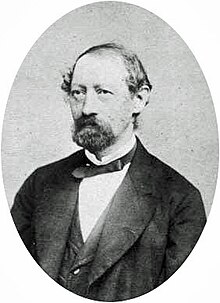| Revision as of 23:02, 28 June 2024 editJJMC89 bot III (talk | contribs)Bots, Administrators3,677,603 editsm Moving Category:Barons of Germany to Category:German barons per Misplaced Pages:Categories for discussion/Log/2024 June 18#Fooian Barons← Previous edit | Latest revision as of 05:39, 28 December 2024 edit undoJohnpacklambert (talk | contribs)Autopatrolled, Extended confirmed users, Pending changes reviewers601,542 editsNo edit summaryTags: Mobile edit Mobile web edit Advanced mobile edit | ||
| Line 80: | Line 80: | ||
| ] | ] | ||
| ] | ] | ||
| ] | ] | ||
| ] | ] | ||
| ] | ] | ||
Latest revision as of 05:39, 28 December 2024
German chess player (1818–1899)| Tassilo von Heydebrand und der Lasa | |
|---|---|
 | |
| Full name | Tassilo, Baron von Heydebrand und der Lasa |
| Country | |
| Born | (1818-10-17)17 October 1818 Berlin, Kingdom of Prussia |
| Died | 27 July 1899(1899-07-27) (aged 80) Storchnest bei Lissa, German Empire (now Osieczna, Poland) |
Tassilo, Baron von Heydebrand und der Lasa (known in English as Baron von der Lasa; 17 October 1818 – 27 July 1899) was a German chess master, chess historian and theoretician of the nineteenth century, a member of the Berlin Chess Club and a founder of the Berlin Chess School (the Berlin Pleiades).
Name
His name is usually abbreviated as "von der Lasa", as this is how he signed his letters. However both contemporary and more recent writers have used other abbreviations, such as "von Heydebrandt" (which is a misspelling) and "Der Lasa". The Prussian King (later Emperor) William I made a joke out of the confusion by saying, "Good morning, dear Heydebrand. What is von der Lasa doing?"
Biography
Von der Lasa was born 17 October 1818 in Berlin. He studied law in Bonn and Berlin. From 1845 he was a diplomat in the service of Prussia. His career took him to Stockholm, Copenhagen, and Rio de Janeiro, among other places. He retired from the diplomatic service in 1864, and thereafter devoted himself to the world of chess.
He played several matches and defeated the strongest masters in the period 1843–1853. He won against Henry Thomas Buckle 2-1 (1843), Adolf Anderssen 4-2 (1845), Johann Löwenthal 6-1 (1846), John William Schulten 4-1 (1850), Anderssen 10-5 (1851), and Howard Staunton 7-6 (1853).
To the modern chess world he is known above all as the main author of the Handbuch des Schachspiels (first published in 1843). His friend Paul Rudolf von Bilguer, responsible for the original plan, had died in 1840, with the work still in the early stages. Von der Lasa took over, and, in a noble gesture of friendship, put his friend's name as author. In later editions of the Handbuch, in German commonly called der Bilguer, von der Lasa was named as co-author.
In 1850 von der Lasa published in the Deutsche Schachzeitung (German Chess Magazine) a call for an international chess tournament, the first ever, to be held in Trier. Instead the first such tournament was held in 1851 in London. Von der Lasa did not play in tournaments, being usually busy as an organizer, but played well in off-hand games against such leading masters as Howard Staunton and Adolf Anderssen. He was also a renowned chess investigator and theoretician, publishing numerous articles in the German Chess Magazine and, in 1897, his great work Zur Geschichte und Literatur des Schachspiels, Forschungen (Researches in the History and Literature of Chess). In the course of his researches he traveled extensively (including a trip around the world in 1887–88) and accumulated a comprehensive chess library, to which he published a catalog in 1896. In 1898 the German Chess Federation saluted his tireless efforts and accomplishments by conferring on him its first honorary membership.
One of von der Lasa's last services was to encourage H. J. R. Murray to pursue further researches into the early history of chess. Von der Lasa died on 27 July 1899 in Storchnest bei Lissa, Posen (then in Prussia, now Osieczna in Poland). His library is still intact at Kórnik Castle near Poznań.
Notes
- See for example the letter he wrote following Howard Staunton's death, which was published in von der Lasa (November 1874). "(title unknown)". The City of London Chess Magazine., reproduced at Harding, T. "A History of The City of London Chess Magazine (Part 2)". Retrieved 2008-07-20.
- Notes on a game Von der Lasa vs G. Nielsen at Copenhagen, in The City of London Chess Magazine: William Norwood Potter (1874). "(title unknown)". The City of London Chess Magazine., reproduced at Harding, T. "A History of The City of London Chess Magazine (Part 2)". Retrieved 2008-07-20.
- Uhl, W. (1905). "Heydebrand und der Lasa, Tassilo von". Allgemeine Deutsche Biographie. Vol. 50. Leipzig. p. 297. Retrieved 2008-07-21.
{{cite book}}: CS1 maint: location missing publisher (link). - "Welcome to the Chessmetrics site". www.chessmetrics.com. Retrieved 20 January 2016.
- "I grandi matches 1850 - 1864". xoomer.virgilio.it. Archived from the original on June 13, 2004. Retrieved 20 January 2016.
References
- H. J. R. Murray, A History of Chess
- Vlastimil Fiala (Ed.): Tassilo von Heydebrand und der Lasa and his chess collection: international conference of chess historians, September 16–18 (2003). Biblioteka Kórnicka, 2003. ISBN 83-85213-38-4
External links
- Tassilo von Heydebrand und der Lasa player profile and games at Chessgames.com
- Jeremy P. Spinrad: Baron von Heydebrand und der Lasa (2006) ChessCafe.com
- 1818 births
- 1899 deaths
- German barons
- German chess players
- 19th-century German historians
- Diplomats for the Kingdom of Prussia
- German chess writers
- Chess historians
- Chess players from Berlin
- People from the Province of Brandenburg
- 19th-century chess players
- 19th-century German male writers
- 19th-century German writers
- German male non-fiction writers
- Sportspeople from the Kingdom of Prussia